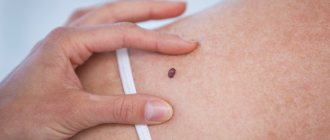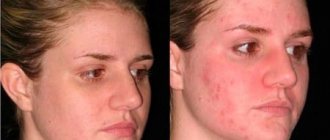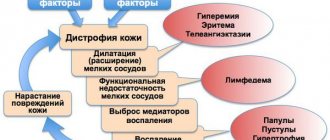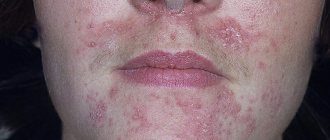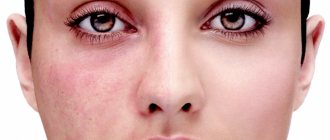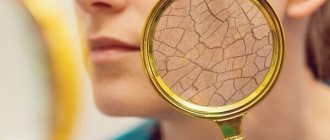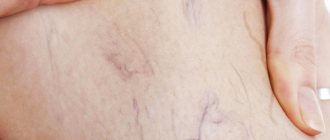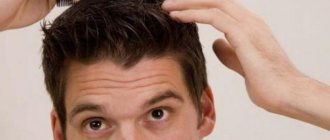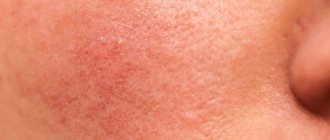Human skin is an organ that is exposed to external factors every day. With increased sensitivity and disruption of the sebaceous glands, rashes appear. Not only young girls and boys are concerned about solving this problem; acne has “matured” significantly over the past 10 years. Rashes on the face systematically occur in people of both sexes of all ages. Why do pimples and acne appear, is it possible to get rid of them once and for all, read on. Let's talk about common rashes and present their classification according to severity.
What is atopic dermatitis
Atopy is a special type of allergic hypersensitivity of the body, which is associated with the development of asthma, hay fever and chronic dermatitis (skin inflammation).
Atopic dermatitis occurs most often in children, including infants, although the disease can develop at any age. The pathology is characterized by a chronic course with periodic exacerbations. With age, the disease usually goes into a stage of long-term remission.
The disease affects 10–20% of the population, and 90% of patients are children under 5 years of age. Among infants under one year of age, the prevalence of the disease is about 10%.
Causes and forms of atopic dermatitis in children and adults
The causes of atopic dermatitis are not precisely known. The disease occurs in people genetically predisposed to it, who have additional immune disorders, under the influence of unfavorable factors. This pathology is not contagious.
Allergic atopic dermatitis can develop under the influence of the following trigger factors:
- contact: allergens (animal hair) or irritants (soap, detergent, perfume, gasoline and other organic substances);
- inhalation: dust, pollen, mold, particles of human and animal dander;
- infectious: Staphylococcus aureus, candidiasis pathogens;
- food: eggs, milk, legumes, citrus fruits, fish, peanuts, cereals (a reaction to them is an indicator of severe dermatitis).
Clinical forms of atopic dermatitis:
- exudative: reminiscent of eczema, characterized by acute inflammation, swelling, weeping and itching;
- erythematous-squamous: thickened skin turns red, acquires a darker shade, and multiple scales form on its surface;
- lichenoid: thickened skin with constant scratching and scratching, often accompanied by a secondary bacterial infection.
In adults, the lesion is most often located on the flexor surfaces of the elbows, under the knees; in young children, the rash appears on the face and extensor surfaces of the joint.
Stages and symptoms of the disease. Diagnosis of atopic dermatitis
The stages of atopic dermatitis usually depend on the age of the patient.
- In infants at 2–3 months, a rash first appears on the cheeks and chin, which turns red, enlarges and begins to become weeping. As soon as the child begins to crawl, such blisters appear on exposed areas of the elbows and knees. The child is restless due to itching and constant skin irritation. By 1.5 years, the disease activity gradually subsides.
- In older children, the rash appears behind the knees, on the inside of the elbows, on the neck, wrists, ankles, and hands. It is represented by compactions, which are then covered with scales from constant scratching. The skin around the lips becomes inflamed and painful cracks appear on it. In severe cases of the disease, the child's growth slows down. After puberty, the manifestations of the disease disappear in almost all patients.
- Some adults have been ill since childhood; the first manifestation of the disease in adulthood is less typical. Symptoms of the pathology are typical, most often the limbs are affected, and a rash around the nipples occurs. There is dryness, cracks and itching of the skin on the arms and legs. Sleep and performance suffer. One of the common concomitant diseases in this case is early cataracts, so patients with atopic dermatitis need to be regularly examined by an ophthalmologist.
Symptoms of atopic dermatitis:
- the main symptom is itching of the skin, accompanied by scratching and secondary infection;
- during the period of remission, dry skin and cracking are noted;
- During the period of exacerbation, weeping crusts form in the affected areas, the skin turns red and swells.
Diagnosis of atopic dermatitis should be carried out by an experienced dermatologist. It is based on an assessment of the external skin reaction and the patient’s complaints. A special scale of disorders has been developed, with the help of which the diagnosis is confirmed.
Additionally, the blood is examined to determine the number of eosinophils (allergic cells) and specific immunoglobulins E (antibodies to specific allergens).
Skin biopsy and skin allergy tests are not used in the diagnosis of atopic dermatitis.
Types of rashes on the face:
- comedo. Another name is a sebaceous plug, which clogs a pore and can cause serious inflammation. This is the stage at which the problem arises. Comedones are white and black, open and closed. With adequate care and high-quality cleansing, they quickly disappear; if an infection occurs, they turn into papules;
- pustule. Red neoplasm with purulent contents. After maturation, a white dot appears at the site of inflammation;
- papule. A ripe pimple that is accompanied by painful sensations. When pressed, it becomes pale and causes discomfort upon palpation. The color of the papules varies from red to bluish;
- lightning pimple. It occurs in large numbers in people who have suffered from acne for a long time. Fulminant neoplasms are considered the most severe; when they appear, it is necessary to urgently seek medical help. This acne affects locally, provokes a change in the formula of leukocytes in the blood, and is manifested by strong and painful sensations in the muscles and bones;
- nodular cystic pimple. Another severe form of acne develops from a pustule. It occurs in large quantities, causes discomfort and is located deep in the dermis. These rashes are connected by fistulous ducts.
As you can see, painful acne in most cases needs to be treated by a specialist. The complexity of the clinical picture is judged by the severity of acne. There are only four of them:
- Rashes appear on one area of the face. Often they are comedones, and not neoplasms of more serious forms.
- White pimples, papules and pustules predominantly appear in several areas, sometimes also on the body. This degree differs from the previous one in the scale of localization.
- A pronounced inflammatory process, a significant number of rashes and redness are observed. Experts note hyperemia and post-acne.
- Large, spherical pimples affect several layers of the skin and have a red-bluish color. Alternate with atrophic scars.
When analyzing the problem, skin genetics are taken into account. The greater the thickness of the cover, the higher the likelihood of developing seborrhea. Fighting acne at home is only worthwhile in the initial stages; severe forms are the specialty of dermatologists.
Treatment of the disease
Diet for atopic dermatitis:
- limiting or eliminating food allergens;
- refusal of carbonated drinks and confectionery products;
- refusal of spicy, salty, smoked, fried foods, marinades, mayonnaise;
- Fermented milk products, vegetables, and fruits common in the diet are useful.
Folk remedies for atopic dermatitis are used after consultation with a doctor:
- Using only one type of soap and detergent without fragrance;
- applying moisturizers, for example, boiled sunflower oil, to damp skin without wiping it with a towel;
- avoiding hot baths;
- It is useful to add bran decoction, infusion of string and chamomile to warm bath water, as well as a little potassium permanganate to disinfect the skin,
- Compresses made from grated raw potatoes and black tea lotions will help relieve itching.
How to cure atopic dermatitis with medications:
- drug therapy is necessary when conventional skin care products are ineffective;
- ointments and creams with glucocorticoids are most often prescribed;
- effective treatments for atopic dermatitis are ointments based on tacrolimus and pimecrolimus, which can be used even in children.
If necessary, treatment of atopic dermatitis is supplemented with antihistamines, antibiotics, enterosorbents, and sedatives. Phototherapy is prescribed. In severe cases, short courses of glucocorticoids and immunosuppressants are used to relieve exacerbations.
More about acne
Acne is caused by hormonal imbalance. If it is accompanied by improperly selected care, ideal conditions for the growth of bacteria are created. Microorganisms that cause acne are called propionic bacteria.
What should you do if acne appears? It is better to consult a cosmetologist or dermatologist for advice. It is worth reviewing your diet, eliminating sweets, fatty and spicy foods, and coffee. Food must be healthy and fresh, otherwise the problem will get worse.
Daily beauty care is of great importance. The algorithm for correct actions is as follows:
- Removing makeup at the end of the day is mandatory.
- Cleansing with lotion or foam for problem skin.
- Toning (very important for normalizing the functioning of the sebaceous glands and other processes that occur at the cellular level).
- Hydration.
When the seasons change, care is reviewed, and nutrition is added in winter if necessary. In summer, use products with a light formula.
Complications and prevention
A dangerous complication of atopic dermatitis is a secondary infection of damaged skin with the development of pyoderma. To prevent it, it is necessary to thoroughly clean and moisturize the skin, and at the first signs of infection, immediately consult a doctor.
Prevention of atopic dermatitis:
- treatment of gestosis during pregnancy, proper nutrition of the expectant mother, avoidance of food allergens;
- limiting drug treatment for newborns;
- breastfeeding for at least six months;
- a nursing mother's adherence to a hypoallergenic diet;
- proper care of the newborn's skin, the use of mild hypoallergenic products.
To prevent exacerbations in adults, treatment in a sanatorium, psychotherapy, exclusion of provoking factors, and professional retraining are used.
About allergic rashes
Now about situations when small pimples appear on the face. It is possible to disguise these rashes with foundation, but you should not do this so as not to provoke the appearance of purulent tumors. Allergic reactions often cause itching, which is difficult to get rid of. The problem arises for the following reasons: disruption of barrier functions or genetically predetermined reactivity of the skin. In the latter case, anything can provoke an allergy on the face. For example, aggressive weather conditions, food, stressful situations.
Allergic rashes on the face are dealt with as follows:
- use hypoallergenic cosmetics;
- exclude citrus fruits, berries, chocolate, coffee, nuts, honey, canned food from the diet;
- Avoid cosmetic procedures.
If you follow the recommendations, your face will become clear in 7-10 days.
Treatment at the Mama Papa Ya clinic
The Mama Papa Ya clinic chain offers medical services to patients with atopic dermatitis at an affordable price. Our advantages:
- treatment of all family members suffering from this disease;
- recommendations for the prevention of dermatitis in children predisposed to it;
- simultaneous complex treatment by a gastroenterologist, neurologist, dermatologist, ophthalmologist and other specialists;
- prescribing the most modern means for the treatment of dermatitis;
- recommendations for nutrition and skin care;
- various physical procedures to prevent exacerbations;
- recommendations for pregnant women on the prevention of disease in newborns.
You can make an appointment by calling. The clinic's branches are located in Moscow and the Moscow region.
Reviews
Good clinic, good doctor!
Raisa Vasilievna can clearly and clearly explain what the problem is. If something is wrong, she speaks about everything directly, not in a veiled way, as other doctors sometimes do. I don’t regret that I ended up with her. Anna
I would like to express my gratitude to the staff of the clinic: Mom, Dad, and me. The clinic has a very friendly atmosphere, a very friendly and cheerful team and highly qualified specialists. Thank you very much! I wish your clinic prosperity.
Anonymous user
Today I had a mole removed on my face from dermatologist I.A. Kodareva. The doctor is very neat! Correct! Thanks a lot! Administrator Yulia Borshchevskaya is friendly and accurately fulfills her duties.
Belova E.M.
Today I was treated at the clinic, I was satisfied with the staff, as well as the gynecologist. Everyone treats patients with respect and attention. Many thanks to them and continued prosperity.
Anonymous user
The Mama Papa Ya clinic in Lyubertsy is very good. The team is friendly and responsive. I recommend this clinic to all my friends. Thanks to all doctors and administrators. I wish the clinic prosperity and many adequate clients.
Iratyev V.V.
We visited the “Mama Papa Ya” Clinic with our child. A consultation with a pediatric cardiologist was needed. I liked the clinic. Good service, doctors. There was no queue, everything was the same price.
Evgeniya
I liked the first visit. They examined me carefully, prescribed additional examinations, and gave me good recommendations. I will continue treatment further; I liked the conditions at the clinic.
Christina
The doctor carefully examined my husband, prescribed an ECG and made a preliminary diagnosis. She gave recommendations on our situation and ordered additional examination. No comments so far. Financial agreements have been met.
Marina Petrovna
I really liked the clinic. Helpful staff. I had an appointment with gynecologist E.A. Mikhailova. I was satisfied, there are more such doctors. Thank you!!!
Olga
